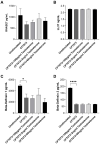Testosterone increases the virulence traits of uropathogenic Escherichia coli
- PMID: 38863749
- PMCID: PMC11165178
- DOI: 10.3389/fmicb.2024.1422747
Testosterone increases the virulence traits of uropathogenic Escherichia coli
Abstract
Uropathogenic Escherichia coli (UPEC) is the most common cause of urinary tract infections (UTIs) in humans. Testosterone negatively impacts UTIs by affecting the immune response, leading to higher susceptibility of chronic cystitis in individuals with elevated testosterone levels, regardless of gender. Current research is mostly focused on how testosterone affects the host response to UPEC, but not so much is known about how testosterone directly affect UPEC virulence. The aim of the present study was to investigate the impact of testosterone exposure on the virulence of UPEC. We found that testosterone directly increases UPEC growth, endotoxin release and biofilm formation. We also found that testosterone-stimulated CFT073 increased colonization and invasion of bladder epithelial cells. Testosterone-stimulated CFT073 also increased the release of IL-1β and LDH from bladder epithelial cells. Additionally, by using a Caenorhabditis elegans survival assay we also showed that testosterone decreased the survival of CFT073 infected C. elegans worms. Taken together, our findings show that testosterone directly increases the virulence traits of UPEC.
Keywords: cross-kingdom interaction; growth; testosterone; uropathogenic Escherichia coli; virulence.
Copyright © 2024 Wu, Pettersson and Demirel.
Conflict of interest statement
The authors declare that the research was conducted in the absence of any commercial or financial relationships that could be construed as a potential conflict of interest.
Figures






Similar articles
-
Estrogen-stimulated uropathogenic E. coli mediate enhanced neutrophil responses.Sci Rep. 2024 Oct 3;14(1):23030. doi: 10.1038/s41598-024-74863-x. Sci Rep. 2024. PMID: 39362931 Free PMC article.
-
Estradiol Alters the Virulence Traits of Uropathogenic Escherichia coli.Front Microbiol. 2021 Jul 20;12:682626. doi: 10.3389/fmicb.2021.682626. eCollection 2021. Front Microbiol. 2021. PMID: 34354683 Free PMC article.
-
Impact of Proinflammatory Cytokines on the Virulence of Uropathogenic Escherichia coli.Front Microbiol. 2019 May 9;10:1051. doi: 10.3389/fmicb.2019.01051. eCollection 2019. Front Microbiol. 2019. PMID: 31143172 Free PMC article.
-
Activation of the NLRP3 Inflammasome Pathway by Uropathogenic Escherichia coli Is Virulence Factor-Dependent and Influences Colonization of Bladder Epithelial Cells.Front Cell Infect Microbiol. 2018 Mar 14;8:81. doi: 10.3389/fcimb.2018.00081. eCollection 2018. Front Cell Infect Microbiol. 2018. PMID: 29662840 Free PMC article.
-
Virulence factors of uropathogenic E. coli and their interaction with the host.Adv Microb Physiol. 2014;65:337-72. doi: 10.1016/bs.ampbs.2014.08.006. Epub 2014 Nov 4. Adv Microb Physiol. 2014. PMID: 25476769 Review.
Cited by
-
Estrogen-stimulated uropathogenic E. coli mediate enhanced neutrophil responses.Sci Rep. 2024 Oct 3;14(1):23030. doi: 10.1038/s41598-024-74863-x. Sci Rep. 2024. PMID: 39362931 Free PMC article.
-
The role of male hormones in bacterial infections: enhancing Staphylococcus aureus virulence through testosterone-induced Agr activation.Arch Microbiol. 2024 Sep 11;206(10):401. doi: 10.1007/s00203-024-04130-0. Arch Microbiol. 2024. PMID: 39261350
-
Immune dynamics throughout life in relation to sex hormones and perspectives gained from gender-affirming hormone therapy.Front Immunol. 2025 Jan 16;15:1501364. doi: 10.3389/fimmu.2024.1501364. eCollection 2024. Front Immunol. 2025. PMID: 39885993 Free PMC article. Review.
References
-
- Akiyama T., Niyonsaba F., Kiatsurayanon C., Nguyen T. T., Ushio H., Fujimura T., et al. . (2014). The human cathelicidin LL-37 host defense peptide upregulates tight junction-related proteins and increases human epidermal keratinocyte barrier function. J. Innate Immun. 6, 739–753. doi: 10.1159/000362789, PMID: - DOI - PMC - PubMed
LinkOut - more resources
Full Text Sources

